Exploring Diverse Shelving Styles for Modern Homes
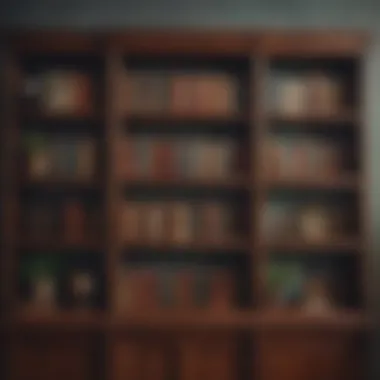
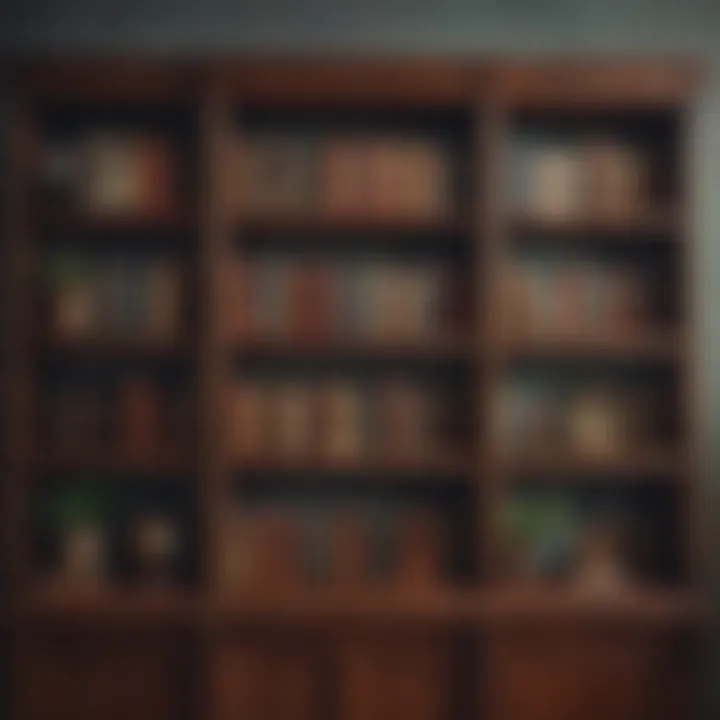
Intro
Shelving styles play a pivotal role in defining the character of a space. It's not just about where to store your books or trinkets; it's about how these elements contribute to the overall aesthetic and functionality of your home. Whether you're deep into interior design or simply looking to spruce up your living room, understanding the rich tapestry of shelving styles can provide valuable insight into your design choices.
Every design choice reflects history, trends, and individual taste, creating layers of meaning behind the shelves we choose to install. Instead of merely providing organizational solutions, shelves often communicate stories about our lives, interests, and aspirations.
Key Insights and Trends
Current Trends in Interior Design
The world of interior design is ever-evolving, with new trends rising to prominence and old styles reimagined. In recent years, there’s been a noticeable shift towards open shelving in kitchens and living areas. This trend emphasizes a more casual and accessible lifestyle, allowing homeowners to showcase their favorite items rather than hide them behind closed doors.
Some other trends shaping the shelving landscape include:
- Sustainable materials: Many homeowners are leaning towards eco-friendly options, such as bamboo or reclaimed wood, that not only serve their purpose but also promote a greener lifestyle.
- Mix of styles: The eclectic blending of modern and vintage is gaining traction, where contemporary shelves serve as a backdrop for antique collectibles.
- Colorful designs: Brightly painted shelves can add an unexpected pop of color to rooms, creating visual interest against neutral walls.
Popular Home Organization Techniques
As people continue to seek organization both for aesthetics and mental clarity, the way shelves are deployed reflects this search. The practice of decluttering has encouraged many to think critically about what their spaces should hold.
Consider these techniques:
- Grouping by color: Arranging books or decor items by color can turn a shelf into a vibrant visual display.
- Themed arrangements: Creating sections devoted to specific interests, such as travel or cooking, adds a personal touch and makes it easier to find items.
- Interactive shelving: Some modern designs encourage interaction by featuring hooks for bags or trays for mail, which helps to integrate shelving into daily life.
"The organization of space is the organization of life."
Practical Tips and How-To Guides
Step-by-Step Guide for Organizing Your Shelves
- Assess Needs: Determine what items you plan to store. This helps you decide the style and size of the shelves needed.
- Purge Unnecessary Items: Before you even think about what you want to fit on your new shelves, ask yourself what you can let go of.
- Choose a Style: Decide whether you want sleek and modern or perhaps something more rustic. This choice affects both the visual harmony of your space and its functionality.
- Arrange with Purpose: Start by placing larger items on the bottom and lighter, smaller objects on higher shelves to create balance.
- Personal Touch: Add personal items that bring you joy, be it books, photos, or collectibles.
Entertaining Tips and Planning Checklists
When hosting gatherings, shelving can serve a dual purpose as both functional storage and eye-catching decor. Use your shelves to display drinks or snacks. Here are some key points to consider:
- Accessibility: Make sure the items you want guests to use are within easy reach, avoiding the need for them to dig through drawers or cabinets.
- Thematic Decoration: Align your shleves' decor with the theme of your gathering, like seasonal items or color-coordinated drinks.
- Create a focal point: Use a distinctive shelf to draw attention, whether it is a stunning piece of art or an arrangement that enhances the overall atmosphere.
In sum, shelving is more than just functionality in your home. It serves as a canvas, reflecting personal tastes that can evolve with changing trends, purposes, and desires. By effectively using these insights and ideas, anyone can elevate their space significantly.
Understanding the Role of Shelving in Interior Design
In the realm of interior design, shelving is more than just a utilitarian structure; it serves as a decorative canvas that shapes the atmosphere and function of a space. Shelves are like the silent workhorses of a room, often overlooked yet playing a starring role in the organization, display, and overall aesthetics of an environment.
Functional and Aesthetic Significance
One cannot underestimate the functional significance of shelving. Effective shelving solutions maximize space, enabling homeowners to store and display cherished items with ease. The strategic placement of shelves can do wonders in a compact setting, transforming cluttered spaces into organized paradises. For instance, a well-placed bookshelf can create a cozy reading nook, while kitchen shelves can provide quick access to essential ingredients, eliminating the frantic last-minute searches.
On the aesthetic front, shelves offer a unique opportunity to express personal style. A floating shelf adorned with travel artifacts can serve as a conversation starter, evoking stories and memories. Colors, materials, and arrangement of items on these shelves can, in fact, reflect an individual’s personality or the desired vibe of the space. Imagine a rustic farmhouse kitchen where open shelves display hand-thrown pottery, harmonizing with the overall theme. Here, shelves transition from mere storage solutions to integral elements of design.
Historical Perspective on Shelving
The evolution of shelving reflects changes in design philosophies, functionality, and cultural aesthetics over time. Historically, the concept of shelving dates back to ancient civilizations. The Egyptians, for instance, utilized intricately carved wooden shelves in their tombs, designed to display items needed in the afterlife.
As we journey through the ages, we notice that shelving designs shifted significantly during the Renaissance period, where ornate, heavy wooden structures emerged as status symbols in wealthy homes. In modern times, the industrial revolution introduced metal shelving units—simple, practical, and affordable, changing how we organized our spaces.
The 20th century saw the rise of minimalist designs, with a focus on function overshadowing extravagance. The iconic designs of the mid-century modern era showcased sleek lines and organic forms, melding seamlessly with contemporary living.
As we analyze these historical contexts, it's evident that shelving is not merely about storing items; it's a reflection of societal values and architectural advancements. Today, we witness an eclectic mix of styles, merging tradition with innovation, creating unique shelving solutions that cater to personal taste and practical needs.
"Shelving serves not just to hold but to highlight, transforming the mundane into extraordinary."
In summary, understanding the role of shelving goes beyond its physical presence. It involves appreciating how functionality, aesthetics, and history intertwine, creating spaces that resonate with those who inhabit them.
Traditional Shelving Styles
Traditional shelving styles hold a timeless appeal that resonates with many homeowners and design enthusiasts. Rooted in historical craftsmanship, these shelving options bring warmth and elegance to living spaces. They often reflect cultural legacies while providing practical storage solutions. The materials and construction techniques used in traditional shelving can greatly influence the overall aesthetic of a room, making them a crucial element of interior design.
Emphasizing classic designs, traditional shelving can enhance the comfort of your home by grounding it in familiar styles that feel inviting. From intricate woodwork to ornate details, these shelving units often stand like sentinel artifacts, showcasing both functionality and artistry. When evaluating traditional shelving styles, it's important to consider the specifics of materials, construction methods, and the visual impact on existing decor.
Classic Wooden Designs
Classic wooden designs are perhaps the most recognized form of traditional shelving. They possess inherent durability and a natural beauty that is hard to rival. The types of wood, from oak to cherry, play a pivotal role in determining the character of the shelves. Each type offers unique grain patterns and finishes that can complement various interior themes.
When choosing a wooden shelving system, consider:
- Finish: Whether you prefer a polished look or a distressed technique can greatly affect the room's vibe.
- Sturdiness: The thickness of the wood and its construction will determine how much weight the shelves can handle.
- Style: From Shaker simplicity to Victorian grandiosity, the choice of style will align with your overall aesthetic.
While traditional wooden shelving often evokes nostalgia, integrating it within a modern context can create striking contrasts. Vintage wooden shelves, laden with books, photographs, or quirky antiques, can become conversation starters.
Curio Cabinets and Display Shelves
Curio cabinets and display shelves take traditional styles a notch further by emphasizing not just storage but also the display of prized possessions. These pieces are often glass-fronted, allowing items within to be showcased while remaining protected from dust and damage.
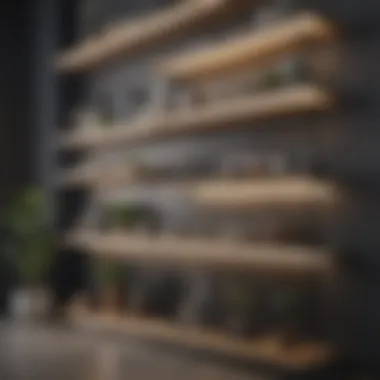
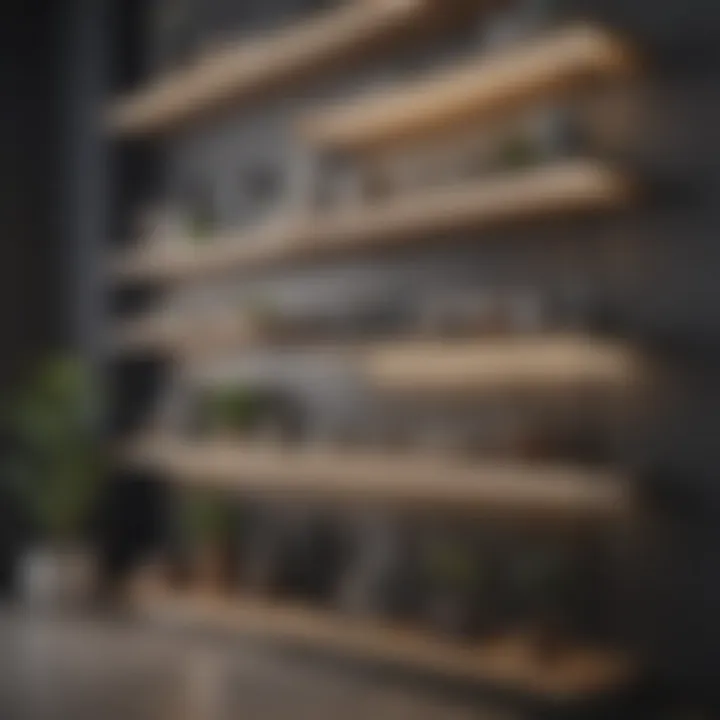
Curio cabinets typically serve as a focal point in a room, often strategically placed to invite admiration:
- Showcasing Collectibles: Whether it's delicate glass figurines or collections of vintage dishes, curio cabinets transform ordinary objects into centerpieces.
- Variable Design Options: They come in a range of styles, from mid-century modern to rustic farmhouse. This variability allows homeowners to match them specifically to their taste and existing decor.
- Incorporating Lighting: Many curio cabinets are fitted with internal lights, spotlighting the items displayed with a soft glow, enhancing their aesthetic appeal.
In homes, curio cabinets can often be found in living rooms, dining areas, or hallways—anywhere they can catch the eye and stimulate conversation.
"Incorporating traditional shelving elements invites not only practicality but also an era's worth of aesthetic flavor into your home."
By choosing traditional shelving styles, you embrace the charm and elegance that these designs have to offer, making them valuable assets for enhancing your living space.
Modern Shelving Styles
Modern shelving styles play a significant role in contemporary interior design, offering both functionality and aesthetic appeal. In a world where space often comes at a premium, and design sensibilities are shifting towards sleek and minimalistic solutions, modern shelving serves as a bridge between maintaining order in one's living environment and expressing personal style. These styles are not just about holding items - they reflect a homeowner’s taste and the overall vibe of a space.
The importance of modern shelving styles lies in their adaptability. They can complement various themes and palettes while providing storage solutions that are both efficient and eye-catching. Homeowners today are looking for ways to maximize their living spaces without compromising on style. Modern shelving solutions meet this demand perfectly, creating layers of depth and interest in the home.
Minimalistic Approaches
When discussing modern shelving, one cannot overlook minimalistic approaches. This design philosophy emphasizes simplicity and functionalism, favoring open spaces and clean lines over bulky or ornate frameworks. Minimalistic shelving is often characterized by an airy aesthetic, allowing for items to be showcased without overwhelming the viewer’s eye.
Several key factors make minimalistic shelving appealing:
- Simplicity: The lack of excessive decoration fosters a calm environment, promoting a sense of tranquility in spaces often cluttered with visual noise.
- Versatility: These shelving units can seamlessly blend into various interiors, from urban lofts to serene country homes.
- Focus on Content: By stripping down the design, the shelving allows the items placed upon it to take center stage, whether that is books, plants, or art pieces.
However, it’s essential to strike a balance when adopting minimalism; too few items can give a cold feeling, while too many can defeat its purpose. Homeowners should consider curating only the pieces that resonate with them, telling a story or reflecting their personal journey.
Floating Shelves and Their Benefits
Floating shelves have carved out a niche for themselves in modern design trends, providing both ideal space utilization and an upscale look. These shelves are mounted directly on the wall, creating the illusion of weightlessness—a quality that can elevate any room’s decor.
The benefits of floating shelves are numerous:
- Space-saving: Unlike traditional shelving units that take up floor space, floating shelves free up valuable real estate.
- Customization: They come in various sizes, materials, and colors, making it easy for homeowners to personalize their selections to fit their specific style needs.
- Functional Art: Because of their sleek look, floating shelves can double as decorative elements. Positioned strategically, they can hold books, display plants, or showcase art without the need for additional furniture.
Floating shelves embody the saying, "less is more." They invite creativity by offering a platform where the only limits are your imagination.
Integrating floating shelves requires careful consideration regarding placement and weight limits. Although they are sturdy when installed correctly, ensuring that wall mounts can bear the load of displayed items is critical.
In summary, modern shelving styles not only enhance spaces but cater to the evolving needs of homeowners and designers. Collectively, the minimalistic approaches and specifics like floating shelves demonstrate a shift towards intelligent design that prioritizes both practicality and aesthetics.
Eclectic Shelving Styles
Eclectic shelving styles offer a refreshing break from conventional design. They emerge from a blend of various design philosophies and materials, enabling homeowners to imprint their very own personality onto their spaces. Rather than confining themselves to a single style, many embrace eclecticism to create an inviting atmosphere that speaks to diverse tastes and experiences. This section reveals how mixing and matching various elements can foster a visually appealing environment.
Mixing and Matching Materials
The notion of blending materials in shelving design isn't just a creative fad; it's an opportunity to establish a dialogue between contrasting elements. When incorporating wood, metal, glass, or even fabric, one opens the door to a myriad of textures and finishes that can dramatically influence the perception of space.
- Wood and Metal: Consider a wooden shelf supported by steel brackets. This duo not only brings a cozy warmth to a room but establishes a robust foundation that is also undeniably stylish.
- Glass and Wood: Featuring glass shelves nestled between wooden frames can impart an airy feel. The see-through nature of glass offers visual lightness while showcasing the items on display, making it ideal for a space that aims to feel more open.
- Eclectic Combinations: The beauty of mixing is that it invites experimentation. One might pair rustic reclaimed wood with sleek metal frames or even colorful painted shelves against neutral backgrounds. Each combination offers a distinct mood that can evoke nostalgia, modernism, or even a bit of whimsy.
Artistic and Asymmetrical Layouts
In an age where perfection often reigns, embracing asymmetry in shelving design is akin to breathing life into the mundane. The charm of art lies in its unpredictable nature, and applying that principle to shelving can transform ordinary spaces into captivating focal points.
Asymmetrical layouts can be both functional and artistic. By arranging shelves in unpredictable patterns, you craft a narrative within the arrangement itself. Here are some ideas to explore:
- Stacked Designs: Think of a vertical storage solution that incorporates staggered layers rather than a traditional parallel setup. It offers the function of storage without sacrificing flair.
- Offsets and Angles: Play with different shelf heights and angles. Having one shelf protrude further than another can add depth and invite the eye to travel across the entire piece.
- Display of Items: This is where personal style comes to life. Mix books with art pieces, plants, or even quirky collectibles. When items are showcased without the confines of symmetry, it becomes a display of memories and stories.
"Eclectic shelving styles remind us that design does not need to follow a rulebook, but instead can reflect individuality and creativity."
In summation, eclectic shelving styles not only celebrate diversity in design but also create spaces that resonate with one’s unique essence. It encourages combining materials and artistic layouts to reflect personal stories while ensuring functionality, making them invaluable in contemporary homes.
Unique Shelving Inspirations
Exploring unique shelving inspirations allows homeowners and design enthusiasts to express their individual tastes and creativity. Shelving serves more than just a storage function; it can transform a space by acting as a canvas for personal style. From displaying cherished collections to making bold design statements, unique shelving can elevate the ambiance of any room.
Industrial Style Shelving
Industrial style shelving embodies a blend of raw aesthetics and functional design. Often characterized by the use of sturdy materials like metal and reclaimed wood, this style harkens back to the days when factories and warehouses were the backbones of urban landscapes.
One key benefit of industrial shelving is its durability. The materials are chosen not just for looks, but for their strength, making them perfect for holding heavier items without worry. Think about steel brackets, exposed piping, and shelves made from weathered planks. Not only do these elements speak to the industrial nature, they also create a certain rugged charm that appeals to many.
Some considerations when integrating industrial shelving into your space include:
- Color Palette: Typically, earthy tones work wonders with industrial elements. Deep browns, blacks, and greys are common, but adding a pop of color can break the monotony.
- Placement: These shelves often work best in loft-style apartments or urban settings. However, incorporating them into more traditional spaces can create a beautiful contrast.
- Accessorizing: Consider incorporating industrial-style decor pieces like vintage clocks or metal accents to tie the room together.
"Shelving is not just a functional element but can be a pivotal point of aesthetic discussion in a room."
Rustic and Farmhouse Trends
Rustic shelving evokes a sense of warmth and comfort. With the heart of the design philosophy rooted in natural materials, rustic and farmhouse trends prioritize homeliness and simplicity. Typically featuring wood that showcases its natural grain and imperfections, these designs draw from the beauty of the countryside.
Farmhouse shelving often incorporates:
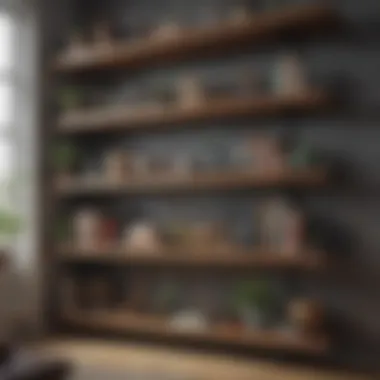
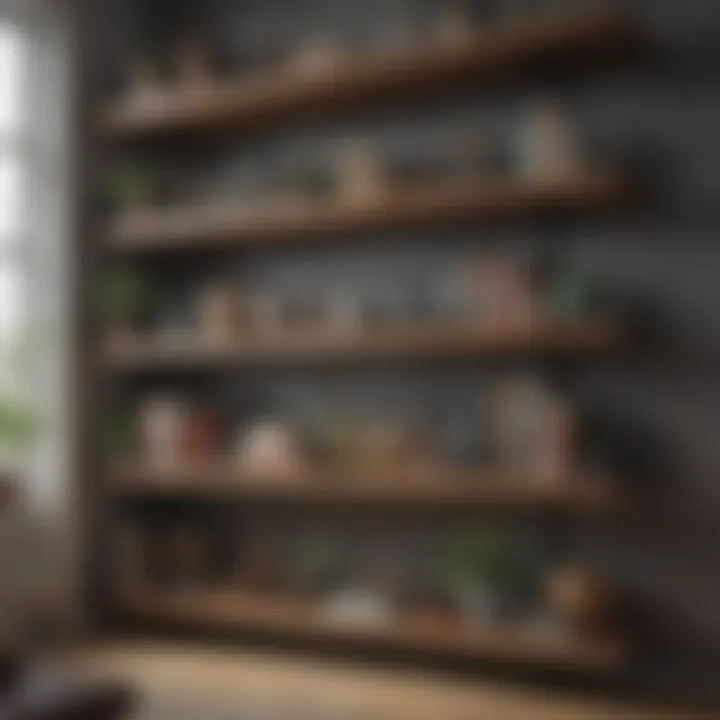
- Reclaimed Wood: Authenticity is key. Using wood that has been repurposed can add character and history to your home. Every chip and scratch tells a story.
- Open Spaces: An open shelving design encourages easy access and a less cluttered look. This trend promotes displaying items you love rather than hiding them away.
- Complementary Decor: Think mason jars, simple ceramic pots, or vintage items that resonate with a cozy, country feel.
Materials Used in Shelving
The materials used in shelving are fundamental to both its functionality and aesthetics. Shelving is not just about storing items; it’s about how those items are displayed and the character they bring to a room. Different materials can influence the strength, appearance, and even the overall design philosophy of a space. Homeowners looking to navigate this vast landscape should weigh the benefits and considerations of each material.
When choosing materials for shelving, it's essential to consider how well they align with the intended use of the shelves, the load they need to bear, and, of course, the existing decor. Let’s take a closer look.
Wood: Types and Treatments
Wood is often the first material that comes to mind when considering shelving. Its natural beauty and versatility allow it to fit into almost any style, from rustic to modern.
There are various types of wood available, each with its unique properties:
- Pine: This softwood is popular due to its affordability and ease of customization. It's lightweight, which is ideal for shelves that won’t carry much weight.
- Oak: Known for its durability and strength, oak is a hardwood that often surfaces in traditional designs. Its delightful grain patterns make it a favorite in high-quality furniture.
- Maple: Another hardwood, maple is hard and strong, great for shelves needing to support heavier items. Its fine grain gives it a smooth finish, complementing modern aesthetics.
- Plywood: Manufactured from thin layers of wood veneer, plywood offers a versatile and strong alternative. It's particularly well-suited for larger shelving units that might otherwise require solid wood’s heftier price tag.
Regarding treatments, wood can be stained, painted, or left raw. Using a protective finish can enhance durability against moisture and scratches, especially important in areas like kitchens or bathrooms. Moreover, a bit of creativity can come into play here:
- Sealing for Protection: Applying varnish or polyurethane can help resist moisture, scratches, and general wear and tear.
- Staining: A stain can bring out the wood's grain, adding depth to its appearance while providing a layer of protection.
- Painting: For those who want a pop of color, painting wood shelves can align perfectly with bold interior design choices.
"Wood’s flexibility in design doesn’t just stop at its aesthetic appeal; it can also enhance functionality based on how it’s treated and crafted."
Metal Shelving: Strength and Versatility
Metal shelving has become increasingly popular in recent years, appreciated for its strength and modern vibe. Unlike wood, metal often conveys a sense of industry, fitting seamlessly into both contemporary and eclectic designs. The ability to bear significant loads is a major plus, making it a practical choice for spaces like garages or utility rooms.
Here are some notable features of metal shelving:
- Durability: Metal shelves can generally withstand more weight than wooden shelves when properly installed. Their strength makes them suitable for heavier items, such as books or tools.
- Static and Mobile Options: Metal shelving comes either as fixed units or movable racks, offering a flexible solution that can adapt as needs change.
- Aesthetic Appeal: With a sleek finish, metal can bring a clean, modern look to a space. Styles range from industrial chic to ultra-minimal.
- Variety in Finishes: Metal can be painted or galvanized to suit individual tastes, making it possible to match or contrast with the existing decor.
When looking at metal shelving, it’s critical to consider the type of metal as well as the finishing it’s received, as these details can drastically impact performance and aesthetics.
In summary, understanding the materials used in shelving allows homeowners and design enthusiasts to make informed choices that enhance not only the utility of their spaces but also the overall design narrative.
The Impact of Color on Shelving Design
Color isn’t just a mere decoration on the wall; it plays a vital role in the overall ambiance and functionality of a space. Shelving, often overlooked in color considerations, can significantly enhance both aesthetic appeal and practicality in home decor. Understanding how color interacts with the design, the atmosphere it cultivates, and the spatial perception it creates is instrumental for homeowners and design enthusiasts alike.
From a practical standpoint, color can affect mood, influence productivity, and even dictate how a room is perceived in terms of size and light. Complementary shades can create harmony, while contrasting hues can add a punch of vibrancy. In essence, the choice of color for shelving isn’t merely cosmetic; it extends to how the space feels and functions. Choosing the right hues makes all the difference between a drab environment and a vibrant, inviting one.
"Color is like cooking. The key is to use the right ingredients."
— Marc Jacobs
This quote truly encapsulates the need to select colors wisely in shelving design to elevate interior spaces.
Neutral vs. Bold Color Choices
When it comes to selecting colors for shelving, homeowners often ponder whether to opt for neutrals or bold shades. Neutral colors such as white, beige, and gray are timeless choices that can effortlessly blend with various decor styles. They create a clean backdrop that allows other elements in the room to shine. For instance, a white floating shelf against a pastel wall provides an airy feel; it also makes any items placed on that shelf stand out.
On the contrary, bold colors like navy blue, deep red, or even vibrant yellow can act as statement pieces. These hues can imbue depth and character into a room, creating focal points that draw the eye. In a minimalist setting, a bright red shelf can serve as an anchor amidst subdued colors, evoking excitement in the atmosphere.
- Pros of Neutral Colors:
- Pros of Bold Colors:
- Timeless appeal
- Versatile across various styles
- Enhances light in a room
- Creates focal points
- Reflects personality and taste
- Adds depth to a space
Choosing between these options can depend on various factors, including the intended ambiance of the space, existing color schemes, and personal style preferences. A well-considered blend of the two can also lead to intriguing designs.
Color Coordination with Home Decor
Coordinating the color of shelves with the overall decor of a home is essential. A well-matched scheme harmonizes the different elements in a room, creating a sense of unity and cohesion. Homeowners should consider the existing palette of furniture, wall colors, and other decor items.
For example, in a cozy, rustic arrangement of wooden furniture, warmer tones like earthy browns or deep greens can complement the natural feel of the space. Alternatively, in modern, sleek decor featuring metal accents, a shelf painted in matte black or metallic hues can enhance the overall aesthetic.
Consider these key points for effective color coordination:
- Assess Existing Colors:
– Look at your primary color palette. - Understand Color Theory:
– Complementary or analogous colors can create visual interest. - Match Finishes and Textures:
– Glossy finishes might contrast nicely with soft textiles.
In the end, color on shelving is more than just visual importance; it's about reinforcing the atmosphere and embracing the individual style that reflects personal tastes. The selection of appropriate colors leads to a vivid dialogue between the shelving and the rest of the decor, ultimately creating an inviting space for family and friends.
Practical Considerations for Shelving
When selecting shelving for a space, it’s essential to balance aesthetics with functionality. Practical considerations heavily influence how well shelves serve their purpose while maintaining beauty. Homeowners and interior design enthusiasts alike must account for factors such as weight capacity, design integrity, placement, and accessibility. These elements not only determine the effectiveness of shelving but also ensure that they harmoniously blend with the overall decor of a home. The decisions made here can enrich a space or lead to unnecessary frustration and disarray.
Weight Capacity and Design Integrity
The weight capacity of a shelving unit is a fundamental aspect that requires careful contemplation. It's tempting to load shelves with a seemingly infinite number of books and decorative items, but doing so without understanding the limitations can lead to mishaps. When selecting shelves, always check the manufacturer's specifications for weight limits. This not only includes the overall capacity but also considers distributed weight, meaning don’t stack too much on one end.
Utilizing high-quality materials is also crucial. Solid woods like oak or maple can handle heavier loads better than particleboard or cheaper alternatives. Ensuring the shelves are well-supported, either through brackets or wall mounting, upholds their structural integrity. A well-installed shelf not only protects your valuables but also poses less risk of collapsing under pressure, which could potentially lead to injury or damage to your decor.
"Fixing a broken shelf is no cakewalk, and the aftermath of spilled collectibles is always a hard pill to swallow."
Placement and Accessibility
Where you place your shelves makes all the difference between practicality and inaccessibility. Optimal placement factors in both usability and design flow. Think about the purpose of the shelving; will it hold frequently used items or be reserved for those precious decorative pieces? If it’s for everyday use—like in kitchens or living rooms—shelves should be easily reachable.
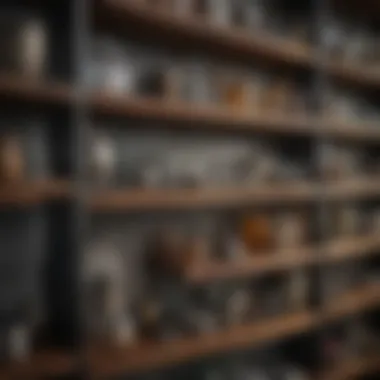
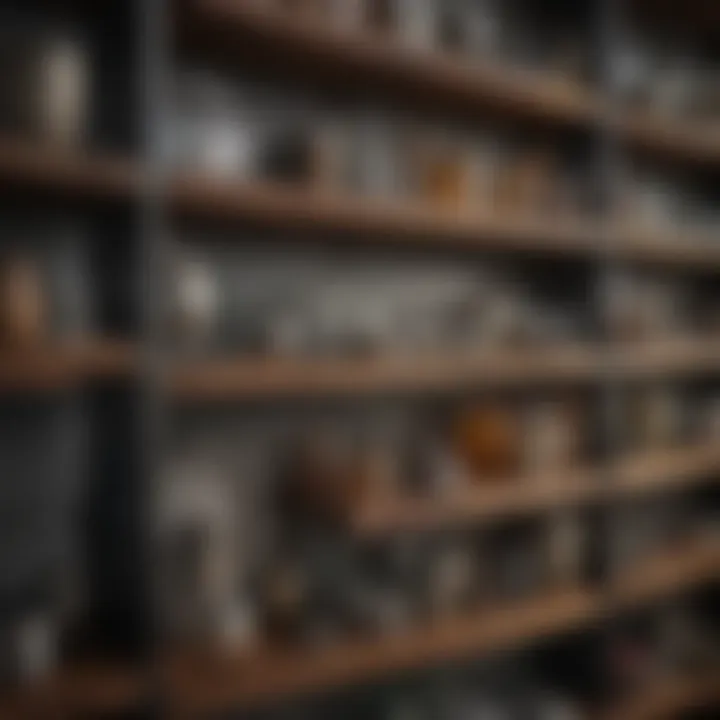
It’s beneficial to consider the vertical space as well. In tighter areas, vertical shelving can maximize storage potential without consuming too much floor space. However, keep in mind that higher shelves may necessitate a ladder or step stool. Therefore, ensuring that the majority of the shelving is within easy reach promotes functionality.
Moreover, when contemplating the type of items to place on shelves, think about their size and shape, as too many bulky objects might result in clutter. Accessibility is not just about reach; it’s also about visibility. Keeping these considerations in mind helps design spaces that are organized, stylish, and user-friendly.
Ultimately, practical considerations wrap around much more than just appearance. It's about building a shelf that stands the test of time, supports what you value, and fits seamlessly into your lifestyle.
Integrating Shelving into Different Spaces
Understanding how to integrate shelving into various spaces can tremendously enhance a home’s functionality and aesthetic appeal. Shelving isn’t just about storing items; it's a dynamic design element that can define the character of a room. By mindfully considering the placement, design, and purpose of shelving, one can strike a balance between style and practicality.
Shelves can serve multiple essential roles in a space. They help organize possessions, accentuate decor, and even create a visual focal point. When choosing shelving, it’s crucial to take into account the specific use of each area in the home. This means evaluating factors such as the surrounding decor, the intended function of the shelves, and how these choices align with the overall design vision. Furthermore, understanding traffic flow and accessibility in each area will help ensure that the shelves are both functional and convenient.
Living Rooms and Entertainment Areas
In the living room and entertainment areas, shelving becomes a means of storytelling. These spaces often serve as the heart of the home, where family and friends gather. Thus, choosing the right shelving can elevate the ambience and reflect personal style.
A well-placed bookshelf can not only hold books but also display treasured mementos or curated art pieces. Floating shelves above a television can cleverly house decorative items, minimizing clutter. Additionally, wall-mounted shelves can expand vertical space, drawing the eye up and making a room feel larger.
Some considerations:
- Balance and Symmetry: Arrange shelves in a way that maintains visual balance. A single tall shelf beside a shorter one may lead to a cramped aesthetic.
- Material Choice: Opt for materials that complement the room's existing decor. For a modern look, sleek metal shelves work well; for a more traditional feel, a wooden finish might be more appealing.
- Functionality: If entertainment is the focus, ensure shelves are placed conveniently near seating areas, allowing easy access to books, games, or decorative items.
"A thoughtful integration of shelving can transform your living space from chaotic to curated."
Kitchens and Utility Spaces
Kitchens and utility spaces often benefit from practical shelving solutions. In these areas, shelves can be both functional and decorative, providing a home for everything from spices to pots, whilst also enhancing the overall aesthetic.
Open shelving in kitchens has gained traction for its ability to showcase beautiful dishware and cookware. It adds an inviting element, making the kitchen feel more open and accessible. However, it's essential to keep practical considerations in mind:
- Ease of Access: Shelves should be at a height that makes items easy to grab. You don’t want to be stretching awkwardly every time you need to grab a spice.
- Durability: Since kitchen shelves endure more wear and tear, materials that withstand humidity and heat, like treated wood or stainless steel, are wise choices.
- Color Coordination: Ensure that the shelving color complements your kitchen's palette. Neutral tones can blend seamlessly, while a pop of color can make a striking statement.
Finally, don’t forget about utility spaces. Utility shelves can organize laundry essentials, gardening tools, or cleaning supplies while maintaining an organized look that keeps everything readily available.
Integrating shelving into these diverse spaces allows homeowners to personalize their environments, optimize organization, and elevate overall decor. The versatility of shelving in living rooms and kitchens proves that it holds significant potential for transforming ordinary areas into cohesive, functional spaces.
Trends in Shelving Styles
In a world where interior design is constantly evolving, staying abreast of trends in shelving styles is not just relevant—it's essential. Shelving plays a pivotal role in defining a space. It can be a focal point or a subtle backdrop, depending on how one chooses to utilize it. Understanding current trends enables homeowners and design enthusiasts alike to make informed decisions.
Gauging the shifts in shelving styles offers several benefits. Firstly, it can reinvigorate dull home environments. By integrating trending styles, spaces can transform from mundane to extraordinary with relative ease. Moreover, aligning with trends can enhance property value. Prospective buyers often look for contemporary features, and effective shelving solutions can significantly influence their perceptions.
As we navigate through today's interior spaces, two key trends stand out: sustainability and smart technology. Both of these trends not only reflect broader societal shifts but also cater to the growing desire for functionality and environmental awareness.
"Good design goes beyond aesthetics; it embraces innovation and responsibility toward our environment."
Sustainable and Eco-Friendly Options
Sustainability has become a hot topic in various sectors, and interior design is no different. When it comes to shelving, opting for sustainable materials can make a world of difference. Bamboo and reclaimed wood, for instance, are gaining traction as greener alternatives to traditional hardwoods. Not only do they reduce carbon footprints, but they also add a unique character to any room.
Additionally, manufacturers have begun focusing on eco-friendly finishes and adhesives to meet the rising demand for safer home environments. Natural oils and water-based stains are much less harmful than their chemical-laden counterparts. Homeowners can look for certifications like the Forest Stewardship Council (FSC), which ensures that the materials used come from sustainably managed forests.
There’s also the aesthetic appeal of using upcycled materials. For example, old wooden pallets or scrap metals can be transformed into stunning shelving units that reflect individuality and creativity. This fabrication process not only showcases personal style but also tells a story of innovation and sustainability.
Smart Shelving Solutions
As technology continues to integrate seamlessly into our daily lives, it's no surprise that smart shelving solutions are carving their niche in modern design. The lighting features on shelves that adjust according to the time of day or the ambient light are just one example of how technology is enhancing usability. Not only do they serve a functional purpose, but they also hold a strong aesthetic appeal.
Another ingenious solution lies in connectable shelving units. These can be adjusted electronically to best fit the needs of one's living space. Imagine adjusting the height of a shelf with a quick press on your smartphone! It's efficient, convenient, and saves the hassle of manual adjustments.
Moreover, integrated charging stations within shelving not only add practicality but also a touch of modernity. For households flush with gadgets, having charging points within reach can streamline daily routines.
Showcasing Personal Style through Shelving
Shelving is more than a mere storage solution in modern home design; it’s a canvas for personal expression. Every piece of shelving—whether floating, built-in, or standalone—offers an opportunity to reflect individual tastes and unique aesthetics. This practice of showcasing personal style through shelving combines practicality with creativity, allowing homeowners and design enthusiasts to create spaces that resonate with their personality. The elements involved in this expression are numerous, ranging from the selection of materials to the thoughtful arrangement of items displayed.
One of the primary benefits of having well-designed shelves is their ability to create a visual narrative within a home. Every shelf can tell a story. Maybe it's a collection of vintage books lined up with pride next to an abstract sculpture. Or it could be a carefully curated display of travel souvenirs that transport one back to far-off lands. These items are not only visually appealing but also serve as conversation starters—"Where did you get that?" or "What’s the story behind this piece?" Such inquiries foster connections and reveal layers of the homeowner’s experiences and journey.
Curating a Personal Library
Transforming a shelf into a personal library isn't merely stacking books haphazardly. It's about creating an inviting space that encourages reading and reflection. Start by deciding on a color scheme or theme. For instance, books with spine colors arranged in a gradient can provide an eye-catching effect, drawing the viewer's gaze. Incorporating other elements like small plants or reading lamps can also enhance this cozy reading nook.
Consider the keywords that represent your interests. Are you a fan of classic literature, or perhaps you lean towards modern fiction? Create sections that reflect your tastes. Some ideas for organizing might include:
- By Genre: Group mystery novels, biographies, and self-help books to make it easier to find what you want.
- By Color: Pulling books of similar colors creates a visually harmonic effect.
- Mixed Display: Alternating books with decorative items keeps the design fresh and engaging.
Arranging the shelves with intention adds a personal touch to your living environment. You might choose to mix hardcovers with curated art pieces, creating a dialogue between literature and visual art. Each shelf can mirror your personal journey and interests, giving it a sense of identity that is distinctly yours.
Displaying Art and Collectibles
Art and collectibles deserve just as much attention as books. They provide a glimpse into a person's character and passions. When it comes to displaying art, the key is to ensure each piece enhances the overall aesthetic of the space. Instead of cramming everything together, take time to thoughtfully position your art. Here are a few strategies to consider:
- Evocative Grouping: Display art pieces from the same period or artist to create a cohesive theme.
- Varied Heights: Use stands or small easels to vary the heights of art pieces, avoiding a flat appearance.
- Incorporate Lighting: Proper lighting can make all the difference. Consider track lighting or spotlights to emphasize important pieces.
Additionally, consider how collectibles fit into your shelve layout. Items like figurines, vintage cameras, or handmade pottery can be arranged to create visual interest. Group them by type or color while leaving enough space for each item to breathe.
As a home evolves, so too should the shelving displays. Changing up what is showcased keeps the environment dynamic, allowing for celebratory moments that match personal milestones or seasonal themes. Perhaps a collection of seashells finds its way onto the shelves during the summer, while a collection of family photos sits proudly during the holiday season.
The shelves you design are more than functional; they embody your life’s story and gateway into your passions.
Showcasing personal style through shelving is an exciting endeavor, merging both creativity and practicality. By curating personal libraries and art displays that resonate with individual tastes, each shelf can transform a simple living space into a vibrant expression of self.



